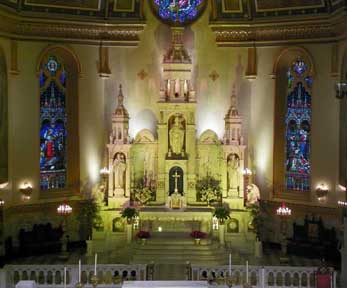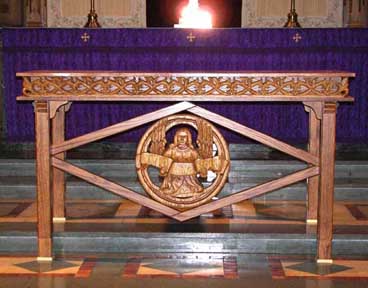Illustrated Architecture Dictionary ............... Illustrated FURNITURE Glossary
Altar/Communion table
![]()
Illustrated Architecture Dictionary
...............
Illustrated FURNITURE
Glossary
Altar/Communion table
 |
 |
A usually raised structure or place on which sacrifices are offered or incense is burned in worship
A tablelike construction used in the Christian church in celebrating the Eucharist
The altar is the table in the chancel that the clergy use for Communion.
During the Protestant Reformation, some people felt that the traditional term was theologically misleading. As a result, many people preferred to call it a Communion Table. Anglicans decided that both terms were correct, because it is the altar from which we receive the sacrifice of Jesus Christ, and because it is the table on which we celebrate Communion. Today, Anglicans and Lutherans generally call it the altar, while churches in the Reform tradition tend to call it a Communion table.
- Rev. Ken Collins' Website (online May 2020)
Altars probably originated when certain localities (a tree, a spring, a rock) came to be regarded as holy or as inhabited by spirits or gods, whose intervention could be solicited by the worshiper. The worshiper's gifts to propitiate or please the gods were placed on an altar nearby.
The earliest Christians used neither temples nor altars in their worship, which was usually conducted in private houses. By the 3rd century AD, however, the table on which the Eucharist was celebrated was regarded as an altar. (The celebration of the Eucharist involves worshipers’ consumption of bread and wine that respectively symbolize the body and blood of Jesus Christ.)
When the Christians began to build churches, a wooden altar table was placed in the choir or in the apse. These altars gradually came to be built of stone, and the remains of martyrs were customarily reburied beneath them. In Western churches from as early as the 4th century, the altar was covered by a canopy-like structure, the baldachin, which rested on columns placed around the altar. The altar was further ornamented by an altarpiece, a screen or wall behind it covered with paintings or sculptures.
During the Middle Ages side altars were built in the larger Western churches so that multiple Masses could be celebrated, sometimes simultaneously.
- Encyclopaedia Britannica (online May 2020)
Examples from Buffalo architecture
- Left Illustration above: St. Stanislaus RC Church
- Left Illustration above: St. John's-Grace Episcopal Church
Other examples:
